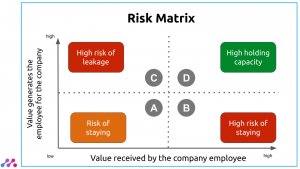It positions talent according to its flight risk.
In this article I am going to explain how to design a risk matrix that allows you to lay the foundations to build an employee value proposition (EVP). It is about exposing how many and who are the employees who are at risk of flight. To do this, you can perform a very simple exercise, drawing a two-axis matrix:
- Coordinate axis (x): value received by the company employee, ordered from lowest to highest.
- Ordinate axis (y): value generated by the employee for the company, also ordered from low to high.
Based on this matrix, four different risk zones or quadrants are generated. In them you can group the members of your teams. Let’s see them, following the attached graphic:

Employees who generate low value for the company.
If you follow the coordinate axis, you can position those employees who, either because of their performance or because of their attitude, generate low value for the company. Now, the consequences will be very different depending on the quadrant that is located according to the ordinate axis.
- Quadrant A: They receive low value from the company. They are employees with a certain risk of staying with the company. They should be monitored to see if they can evolve into other quadrants. The advantage is that, if they evolve towards quadrant C, you will be able to offer them a differentiated value proposition to place them in quadrant D. In any case, you should avoid at all costs that they occupy quadrant B. It depends on you.
- Quadrant B: They receive high value from the company. They are employees with a certain high risk of staying with the company; white elephants. The excess value received by the company can be in the form of compensation (people who were paid for past services, have maintained compensation when performance has declined) or in the form of internal social recognition. As Xavier Marcet says, they are the type of employees that nobody knows exactly how they got there but that everyone knows will never leave. The disadvantage of this group is that they generate comparative grievances with respect to lower-paid and better-performing colleagues. They rarely receive complex tasks when the compensation they receive is corresponding to precisely those types of tasks. And worst of all, it is usually practically impossible to reduce their value proposition.
Employees who generate high value for the company.
This is the reverse situation to the previous one. On paper they are all advantages since they tend to be the best performing employees. Those that every leader wants to have on his team. But not always so clear, depending on which quadrant they are located.
- Quadrant C: They receive low value from the company. They are employees with a certain risk of leaving the company. Be careful, talented people tend to stay in that quadrant for a short time. As a counterpoint to the situation that we detail in quadrant B, if that person lives with others located in quadrant A (or worse, in quadrant B), they end up receiving many tasks and little value from the company. And in the end, they think that the line between being very good and very stupid is very thin, and they are looking for eco-systems that value them. The advantage is that, unlike what we mentioned with respect to employees located in quadrant A, their transition to the upper quadrant depends on you, on the company.
- Quadrant D: They receive high value from the company. They are employees with a high capacity to be loyal in the company. You should also monitor them to maintain that balance between value received and value delivered, and act immediately when you see that balance is lost. We already see what can happen to the white elephants in quadrant B.
The opportunity to build an employee value proposition.
The previous exercise is something that almost all companies have developed, but to retain external customers regarding the brand, product or service. Too bad it has rarely been done with the same energy to build internal customer loyalty.
The advantage is that once completed you will be able to build an employee value proposition aimed at ensuring that the greatest number of employees can be positioned in the D quadrant. A very common mistake is to build that EVP only around financial compensation. It is a hygienic factor, which means that it can cause a loss of commitment if you do not have it, but that by itself usually has a relative value (if they are not accompanied by more motivational factors). That is, therefore, a common misconception that does not provide much traction for D quadrant employees. The more value they generate, the more important the unhygienic factors of the value proposition are to you.
In future articles I will talk about the elements that a value proposition that captivates talent must have.
